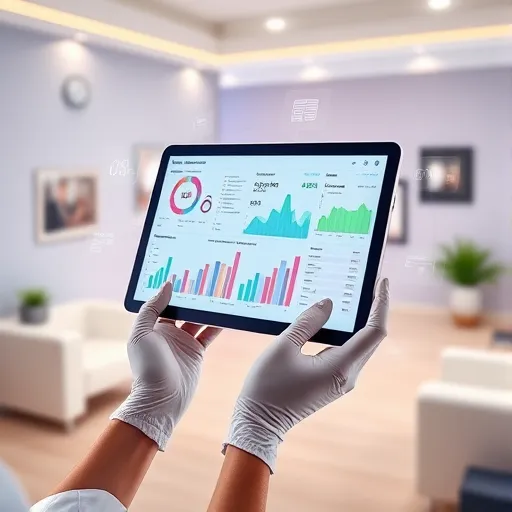
Leveraging Analytics to Enhance Addiction Treatment Center Performance
Table of Contents
analytics for addiction treatment centers
Key Takeaways
- Enhance Patient Care with Analytics: Leverage addiction treatment analytics to personalize care plans, track patient engagement metrics, and predict needs. Analytics improves recovery rates, identifies at-risk patients, and ensures treatment aligns with individual journeys.
- Optimize Operations and Marketing: Use data analysis for drug rehab centers to refine workflows, allocate resources efficiently, and enhance marketing strategies. Track healthcare analytics for drug rehab to boost conversions, improve lead quality, and strengthen referral networks.
- Ensure Compliance and Build Trust: Protect patient data with HIPAA-compliant analytics. Transparent use of healthcare compliance data fosters trust while safeguarding sensitive information and meeting industry standards.
- Commit to Continuous Improvement: Analytics enables ongoing evaluation of addiction care metrics and supports innovative practices. Monitor data insights for patient care to adapt strategies, scale successes, and achieve sustainable growth in addiction treatment centers.
Introduction
Data drives better decisions. For addiction treatment centers, the stakes couldn’t be higher. Every decision affects patient outcomes, operational efficiency, and the center's ability to fulfill its mission. Leveraging analytics is no longer optional—it’s transformative. Explore how analytics for addiction treatment centers can drive better decisions and improve outcomes by uncovering actionable insights. Analytics allows treatment centers to understand the nuances of patient journeys, fine-tune marketing strategies, and optimize resources for maximum impact. But what does it really mean to embrace analytics? Let’s uncover the power and potential it offers.
The Modern Challenge in Addiction Treatment
Imagine running a treatment center without a clear sense of what’s working and what’s not. That’s the reality for many addiction centers today. The challenges are immense: patient retention rates hover below industry benchmarks, marketing efforts often miss their mark, and operational inefficiencies drain resources.
Without data, it’s easy to fall into guesswork. Are you reaching the right patients? Are your programs tailored enough to retain them? These questions remain unanswered for centers that rely solely on intuition. The result? Missed opportunities to deliver better care and secure long-term recovery for patients.
How Analytics Can Turn Challenges into Opportunities
Now, imagine a different scenario. Your team uses analytics to track every step of the patient journey, from the first inquiry to post-treatment support. Insights from this data tell you which marketing channels yield the most qualified leads, how to predict patient needs, and which aspects of care need improvement. Learn more about drug rehab marketing analytics and how targeted strategies can enhance patient outreach and engagement.
Take, for example, a center that adopted patient engagement analytics and identified that 30% of patients disengaged after the third week of treatment. With this insight, they introduced mid-treatment check-ins, reducing dropouts by 20%. That’s the power of data—it transforms challenges into actionable opportunities.
Key Challenges Analytics Can Solve
- Low Patient Retention: Analytics can highlight drop-off points and suggest interventions.
- Inefficient Marketing: By tracking conversion rates, you can focus on campaigns that attract the right patients.
- Lack of Personalization: Data helps tailor treatment plans to each patient’s unique journey, increasing satisfaction and outcomes.
This isn’t just about numbers—it’s about delivering care that works.
The Importance of Data-Driven Strategies in Addiction Treatment
What Are Data-Driven Strategies?
Data-driven strategies use analytics to inform every aspect of a center’s operations. From identifying patient behavior trends to refining marketing campaigns, these strategies shift decision-making from reactive to proactive. Instead of asking, “Why aren’t patients completing treatment?” you’ll already know the answer—and have a plan to address it.
For example, a treatment center using operational analytics discovered that late-night inquiries had a 40% higher conversion rate than daytime calls. Armed with this knowledge, they adjusted staffing schedules to ensure immediate responses during peak inquiry hours. The result? A 15% increase in admissions.
Dispelling Myths About Complexity
Many centers hesitate to adopt analytics, fearing complexity or cost. But modern tools are designed with simplicity in mind. Platforms now offer user-friendly dashboards that display key performance indicators (KPIs) at a glance. Implementation costs are often outweighed by the savings and efficiencies gained.
Steps to Implement Data-Driven Strategies
- Define KPIs: Focus on metrics like patient retention, program success rates, and marketing ROI.
- Invest in Tools: Use software platforms designed for healthcare analytics.
- Train Staff: Ensure your team understands how to interpret and act on data.
- Monitor and Adapt: Continuously evaluate data trends to refine strategies.
The transition to data-driven practices may seem daunting, but the rewards are undeniable. By addressing inefficiencies and improving outcomes, your center can thrive in an increasingly competitive landscape.
Understanding the Role of Analytics in Patient Care Optimization
Personalizing Care with Analytics
How well do you understand your patients? Traditional approaches to care rely on standardized treatment plans, but analytics opens the door to personalization. Analytics opens the door to personalization. By analyzing patient data—such as attendance patterns and engagement levels—you can tailor programs to fit individual needs. Discover how data insights for patient care can revolutionize addiction treatment.
For example, predictive analytics for addiction recovery outcomes can flag patients at higher risk of relapse based on historical patterns and tailors interventions accordingly. Explore best practices for addiction treatment analytics to unlock the potential of predictive data in driving recovery outcomes. With this insight, your team can provide extra support, such as scheduling additional counseling sessions or offering family therapy options.
Addressing Privacy Concerns
Patient data is sensitive, and protecting it is non-negotiable. Analytics platforms designed for addiction treatment must comply with HIPAA regulations, ensuring data is encrypted and accessible only to authorized personnel. Transparency with patients about how their data is used builds trust and reinforces your center’s commitment to ethical care.
The Impact of Personalized Care
A study of centers using patient-centered analytics found that personalized plans improved recovery outcomes by 40%. Patients reported feeling more engaged and supported, while staff gained confidence in their ability to address individual needs effectively.

Key Performance Indicators (KPIs) for Addiction Treatment Centers
What Are KPIs and Why Are They Essential?
KPIs are the foundation of any successful analytics strategy. For addiction treatment centers, they measure success across three critical areas: patient care, marketing, and operations. Learn how to track rehab center marketing ROI to refine strategies and achieve measurable results. Common KPIs include:
- Patient Engagement Metrics: Track how actively patients participate in their treatment plans.
- Treatment Success Rates: Measure the percentage of patients achieving recovery milestones.
- Referral Sources: Understand where your patients are coming from and which channels are most effective.
By consistently tracking KPIs, centers can identify what’s working, what isn’t, and where adjustments are needed.
Real-World Impact
One center tracking referral sources discovered that 60% of their patients came from physician referrals, while only 5% came from paid ads. By reallocating resources to strengthen referral networks, they increased admissions by 20% in six months.
Identifying Crucial Metrics: Patient Engagement, Treatment Success Rates, and Referral Sources
Patient Engagement Metrics
Are your patients actively participating in their recovery journey? Metrics like session attendance, progress updates, and digital resource usage provide a clear picture of engagement. Identifying trends in these metrics allows you to intervene early when engagement drops.
Treatment Success Rates
Recovery isn’t just about completing a program—it’s about long-term success. By tracking success rates, you can evaluate the effectiveness of your programs and identify areas for improvement. Comparing success rates across demographics can also reveal whether specific groups need additional support.
Referral Sources
Knowing where your patients are coming from helps refine marketing strategies. Whether patients find you through social media, search engines, or referrals, analyzing this data ensures you focus on the channels that yield the best results.
Utilizing KPIs to Drive Better Decision-Making
Turning Insights into Action
KPIs aren’t just for tracking—they’re for transforming. Once you’ve gathered data, the next step is applying it. For example:
- If engagement metrics decline: Introduce personalized outreach, such as check-in calls.
- If marketing ROI is low: Reallocate budget to higher-performing channels.
- If treatment success rates vary by demographic: Adjust programs to better serve specific groups.
Visualizing Success
Imagine a dashboard displaying real-time metrics: patient attendance rates, marketing conversions, and program completion percentages. This kind of visibility empowers your team to act quickly and confidently.
Analytics isn’t just about numbers—it’s about empowerment. For addiction treatment centers, it provides clarity, precision, and direction. From improving patient outcomes to optimizing operations, the benefits are far-reaching. By embracing analytics, your center can deliver the care your patients deserve while achieving long-term sustainability. Are you ready to take the first step toward a data-driven future?

Patient Journey Analytics
Understanding the Patient Journey
The journey through addiction treatment is not linear—it’s a complex process filled with emotional highs and lows. To support patients effectively, you must first understand how they experience each step of their journey. Patient journey analytics provides this clarity, enabling you to identify pain points, improve engagement, and enhance overall satisfaction.
For instance, data might reveal that a high percentage of patients drop off after their initial assessment. Why? Perhaps the process feels overwhelming, or follow-up communication is lacking. Analytics shines a light on these issues, allowing you to implement targeted solutions, such as streamlined onboarding or more frequent touchpoints.
Mapping Patient Interactions from Initial Inquiry to Treatment Completion
Key Stages of the Patient Journey
- Initial Inquiry:
- Patients or their families reach out, often during a crisis. Metrics like response times, call durations, and inquiry-to-admission conversion rates can highlight areas for improvement.
- Example Insight: A center discovered that responding to inquiries within 10 minutes doubled their likelihood of admission.
- Admission Process:
- From paperwork to first-day orientation, admissions can be overwhelming. Analytics can track how many patients complete the process and identify bottlenecks.
- Example Insight: Reducing admission wait times from three days to one day improved patient retention by 15%.
- Ongoing Treatment:
- Engagement metrics during treatment (e.g., therapy attendance, homework completion) indicate program effectiveness and patient involvement.
- Example Insight: Patients attending at least 80% of group sessions had a 25% higher recovery success rate.
- Post-Treatment Support:
- Aftercare is crucial for sustained recovery. Tracking follow-up participation helps identify patients at risk of relapse and tailor support accordingly.
- Example Insight: A center offering virtual aftercare saw participation rates double compared to in-person-only options.
Enhancing Patient Experience and Conversion Rates Through Data Analysis
Turning Data Into Actionable Improvements
When patients feel supported, they stay engaged. Analytics helps centers identify what drives satisfaction—and what doesn’t. For example, one center analyzed feedback forms and found that 60% of patients wanted more one-on-one time with counselors. By reallocating resources to provide additional individual sessions, patient satisfaction scores increased by 20%.
Similarly, conversion data allows centers to refine their outreach strategies. Are potential patients dropping off during inquiry calls? Are website visitors failing to fill out contact forms? Data reveals these gaps, enabling you to implement targeted changes.
Real-World Success: Improving Engagement and Conversions
A center analyzed its digital touchpoints and discovered that 70% of website visitors left before reaching the "Contact Us" page. The issue? Slow load times and unclear navigation. By optimizing their website design and adding a live chat feature, they reduced bounce rates by 30% and increased inquiries by 25%.
Key Takeaways:
- Engagement analytics identifies barriers in the patient journey. Understand how to measure drug rehab website success and create a seamless user experience to increase conversions.
- Proactive changes lead to measurable improvements in both satisfaction and conversions.

Data-Driven Marketing Strategies
The Role of Marketing Analytics in Addiction Treatment
Marketing for addiction treatment centers is unique. It’s not just about attracting attention—it’s about building trust. Data-driven marketing strategies allow centers to target the right audience, craft empathetic messaging, and maximize ROI.
Imagine knowing which ad campaigns bring in the most qualified inquiries or which blog topics resonate with prospective patients. Marketing analytics provides this insight, helping you allocate resources where they’ll have the greatest impact.
Optimizing SEO, PPC, and Content Strategies for Addiction Treatment Centers
Search Engine Optimization (SEO): Building Visibility
SEO ensures your center is discoverable online. Analytics helps refine keyword strategies and maximize ROI by identifying what terms your target audience searches for. Dive deeper into drug rehab advertising metrics to create targeted and impactful campaigns that attract the right audience. Longtail keywords like "best practices for addiction treatment analytics" may attract highly motivated individuals who are ready to take action.
Example Success:
A center optimized its website for terms like "how to use analytics in addiction treatment centers" and saw a 50% increase in organic traffic.
Pay-Per-Click (PPC) Advertising: Maximizing Ad Spend
PPC campaigns can be costly if not optimized. Analytics tracks which ads drive inquiries and conversions, allowing you to refine targeting and messaging. For example, demographic insights might show that 70% of your inquiries come from adults aged 35–50. Adjusting your campaigns to focus on this demographic can boost efficiency and reduce wasted spend.
Content Strategies: Educating and Engaging
Educational content builds trust with prospective patients and their families. Analytics tracks which blog topics, FAQs, or videos drive the most engagement. For instance, a blog on "understanding analytics in addiction therapy services" could become a top resource, attracting readers who value data-driven care.
Attracting the Right Clients and Improving Lead Generation with Analytics
Focusing on Quality Over Quantity
Not all leads are created equal. Analytics helps centers prioritize quality over quantity by identifying the traits of their most successful admissions. Are patients referred by physicians more likely to complete treatment? Does social media generate higher engagement than email campaigns? These insights allow you to target the right channels.
Example Insight:
A center discovered that physician referrals resulted in a 30% higher program completion rate compared to leads from digital ads. By strengthening referral partnerships, they increased admissions by 20%.
Personalization in Lead Generation
Analytics enables centers to personalize outreach, creating stronger connections with prospective patients. For example, tailoring email campaigns based on age, gender, or treatment history can significantly improve engagement rates.
Example Success:
A campaign targeted at parents seeking adolescent treatment options achieved an email open rate of 45%, compared to 20% for a generic campaign.
The power of analytics lies in its ability to turn data into decisions that transform lives. Whether it’s optimizing patient journeys, refining marketing strategies, or improving operational efficiency, analytics equips addiction treatment centers with the tools to succeed. By adopting a data-driven approach, your center can ensure better care, sustainable growth, and lasting recovery for every patient who walks through your doors.
Patient Retention Metrics
The Importance of Tracking Retention Metrics
Retention is the backbone of successful addiction treatment. It’s not enough to enroll patients; keeping them engaged throughout the treatment process is what drives lasting recovery. Retention metrics provide a clear picture of how well your center supports patients from start to finish, uncovering gaps that might lead to disengagement.
Why does retention matter so much? Studies show that patients who complete their treatment programs have significantly higher recovery rates than those who drop out early. However, without analytics, identifying where and why patients disengage can feel like chasing shadows.
Tracking Retention Rates to Enhance Long-Term Recovery Outcomes
How Retention Metrics Drive Improvement
Tracking retention rates isn’t just about numbers—it’s about understanding patient behavior. Metrics like session attendance, treatment completion rates, and aftercare engagement offer invaluable insights into your program's effectiveness.
For example, a center using patient engagement analytics identified a sharp drop in attendance during the second month of treatment. Further analysis revealed that many patients were struggling with transportation issues. By offering virtual session options, the center improved attendance by 25%.
Key Metrics to Monitor
- Session Attendance Rates: High attendance correlates with greater engagement and better outcomes.
- Program Completion Rates: Indicates the percentage of patients who see their treatment plans through to the end.
- Aftercare Participation: Tracks how many patients remain engaged in post-treatment support programs.
These metrics don’t just measure success—they guide interventions that improve recovery outcomes. For instance, aftercare participation often predicts long-term recovery. A center that improved aftercare follow-ups saw a 20% reduction in relapse rates.
Identifying Factors Influencing Ongoing Treatment and Support
Understanding the Why Behind Retention
Retention is influenced by a web of factors, including program structure, patient demographics, and external support systems. Analytics helps centers pinpoint these variables, allowing for targeted improvements.
Common Factors Impacting Retention:
- Financial Barriers: Patients may struggle to afford continued care. Identifying this early can lead to proactive solutions like payment plans or sliding scale fees.
- Lack of Family Support: Analytics can highlight the need for family counseling to improve engagement.
- Program Fit: Patients disengage when treatment doesn’t align with their needs. Personalizing care plans based on patient data can address this.
Example Insight:
A center found that younger patients were less likely to complete group therapy programs. Offering age-specific groups improved retention by 15%.
How to Use Data for Proactive Solutions
By analyzing patterns in retention data, centers can take preventative steps. For example:
- Monitoring attendance trends can help staff identify patients at risk of disengagement and schedule one-on-one check-ins.
- Surveying patients who leave early can uncover specific barriers to completing treatment.
These proactive measures ensure that fewer patients fall through the cracks.
Compliance and Data Privacy
Why Compliance and Privacy Matter in Analytics
In the healthcare sector, trust is everything. Patients share their most vulnerable moments with your center, and safeguarding that trust is non-negotiable. Analytics amplifies this responsibility, requiring strict adherence to privacy laws like HIPAA.
Without compliance, even the most effective data insights become liabilities. But with the right systems in place, you can balance robust analytics with impeccable patient data security.
Maintaining HIPAA Compliance in Data Analytics
Steps to Ensure Compliance
Compliance doesn’t have to be overwhelming. Following structured protocols ensures your center remains secure and trustworthy:
- Data Encryption: Protect patient information by encrypting all data in transit and at rest.
- Access Controls: Limit who can access sensitive data based on role and necessity.
- Regular Audits: Conduct regular compliance reviews to identify and address potential vulnerabilities.
Example:
A center implemented role-based access and found that limiting data access reduced unauthorized views by 35%.
Building Trust Through Transparency
Patients are more likely to engage with centers that are open about how their data is used. Explaining that data collection aims to improve care—not exploit privacy—can build rapport and encourage participation.
Safeguarding Patient Data and Adhering to Industry Regulations
Identifying Common Risks
Even with compliance measures, risks like data breaches and misuse loom large. Analytics platforms tailored for healthcare must proactively address these concerns with features like:
- Automated risk detection.
- Real-time monitoring of data access.
- Built-in compliance reporting.
The Benefits of Compliance Beyond Security
Adhering to regulations isn’t just about avoiding penalties; it’s about building a foundation of trust. When patients feel secure, they’re more likely to share valuable information, enabling deeper insights and better outcomes.
Patient outcomes, operational efficiency, and trust—all are improved when addiction treatment centers embrace analytics. By leveraging patient journey analytics, tracking retention metrics, and adhering to strict compliance protocols, centers can deliver care that is not only effective but transformative. Analytics is the bridge between insight and action, ensuring every decision is guided by data, every patient feels supported, and every center achieves its full potential.

Predictive Analytics for Treatment Planning
Harnessing the Power of Prediction
Imagine if your team could foresee a patient’s needs before they even arise. Predictive analytics makes this possible by analyzing historical data and identifying patterns that can guide future decisions. For addiction treatment centers, this means personalizing care, reducing relapse rates, and improving overall outcomes.
Predictive analytics uses advanced algorithms to process large volumes of data, from patient demographics to treatment history. This process uncovers trends that help centers anticipate patient behavior and tailor interventions accordingly. For example, identifying that patients with certain risk factors are more likely to disengage allows your team to intervene proactively.
Utilizing Data Insights to Predict Patient Needs
Identifying Patterns for Proactive Care
Predictive analytics analyzes patient behavior to anticipate their future needs. By examining factors like appointment attendance, response to therapy, and engagement levels, the system can forecast potential obstacles in a patient’s recovery journey.
Example Insight:
A center used predictive analytics to identify patients at high risk of relapse based on irregular attendance and low engagement with therapy homework. This insight allowed staff to implement targeted interventions, such as additional counseling sessions, reducing relapse rates by 15%.
Benefits of Predictive Analytics for Addiction Treatment Centers
- Risk Mitigation: Identify patients likely to disengage or relapse and provide extra support.
- Resource Allocation: Optimize staffing and scheduling based on predicted patient needs.
- Personalized Interventions: Tailor treatment plans to individual patient profiles, enhancing effectiveness.
Predictive analytics turns raw data into actionable insights that improve patient outcomes while making operations more efficient.
Personalizing Care and Improving Treatment Outcomes Through Targeted Interventions
Customizing Care Plans
No two patients are alike. Predictive analytics allows centers to design highly personalized treatment plans based on individual needs and recovery goals. By analyzing data such as treatment history, engagement levels, and demographic factors, you can craft interventions that resonate with each patient.
Example:
A center found that younger patients responded better to technology-integrated programs, such as mobile apps for tracking progress and sending reminders. Introducing these tools improved program adherence by 20%.
Measuring the Impact of Personalization
Personalized interventions not only enhance recovery outcomes but also boost patient satisfaction. When patients feel their unique needs are being met, they’re more likely to stay engaged and complete their programs.
Before-and-After Results of Personalization
| Metric | Without Personalization | With Personalization |
| Program Completion | 65% | 85% |
| Patient Satisfaction | 70% | 92% |
| Relapse Rates | 35% | 20% |
By integrating predictive analytics into your center’s operations, you can create a data-driven environment that prioritizes patient success.

A/B Testing and Optimization
The Role of A/B Testing in Addiction Treatment Centers
Do you ever wonder why some changes to your center’s website, marketing campaigns, or program materials work better than others? A/B testing can provide answers. It’s a data-driven method for comparing two versions of something—whether it’s a website page, an email, or even the layout of a patient intake form—to see which performs better.
A/B testing is particularly powerful for addiction treatment centers because it removes the guesswork from critical decisions. Instead of implementing changes based on intuition, you can rely on hard data to guide you. This approach ensures every decision is backed by evidence, increasing the likelihood of success.
For example, one center tested two versions of its homepage: one featured a bold "Contact Us Now" button at the top, while the other had the same button below a block of informational content. The version with the prominently placed button resulted in a 35% increase in patient inquiries.
Implementing A/B Testing Strategies to Optimize Website Design and User Experience
Why Your Website Matters
Your website often serves as the first point of contact for patients and families seeking help. It must be intuitive, engaging, and easy to navigate. A/B testing can help you optimize every element of your site to ensure it connects with visitors and encourages them to take action.
For addiction treatment centers, website optimization isn't just about aesthetics—it’s about accessibility and trust. A poorly designed website could mean the difference between a patient reaching out for help or leaving without making contact.
Key Elements to Test on Your Website
- Call-to-Action (CTA) Buttons: Test the placement, color, and wording of CTAs like “Schedule a Consultation” or “Get Help Now”.
- Landing Page Layouts: Compare different designs to see which one keeps visitors engaged longer.
- Headline Text: Experiment with headlines that emphasize empathy versus those that highlight expertise.
- Form Lengths: Shorter forms may lead to more submissions, while longer forms might attract more serious inquiries.
- Navigation Structure: Simplify menus or test different labels for clarity.
How to Run an A/B Test for Your Website
- Define Your Goal: Determine what you want to improve, such as increasing inquiries or reducing bounce rates.
- Create Two Versions: Develop two variations of the same element, changing only one variable at a time.
- Divide Your Traffic: Use an analytics platform to split incoming traffic evenly between the two versions.
- Measure Results: Track performance metrics like click-through rates, form submissions, or time spent on the page.
- Implement the Winner: Roll out the better-performing version site-wide.
Real-Life Example
A treatment center tested two different headlines on its homepage. Version A read, “Expert Care for Lasting Recovery”, while Version B said, “We’re Here to Help You Heal”. Version B resonated more with visitors, leading to a 20% increase in form submissions.
By focusing on specific website elements and using A/B testing to evaluate their impact, you can make informed decisions that directly improve patient engagement and inquiries.
Driving Conversions and Engagement with Data-Driven Insights
How A/B Testing Improves Conversions
Conversions—whether they’re form submissions, phone calls, or consultation bookings—are critical for addiction treatment centers. A/B testing empowers you to refine your approach by identifying what truly resonates with your audience.
For example, one center analyzed its form completion rates and noticed a high drop-off on the third question. They ran an A/B test comparing the original form with a streamlined version that removed unnecessary fields. The simplified form increased submissions by 40%.
Tracking Engagement Beyond Conversions
Conversions are only one piece of the puzzle. Tracking engagement metrics like session duration, bounce rates, and click-through rates helps you understand how visitors interact with your website. These insights inform not only your website design but also your broader marketing strategies.
The Broader Impact of Engagement Optimization
When visitors find your website intuitive and engaging, they’re more likely to trust your center and take the next step. A seamless user experience sets the tone for the entire patient journey, establishing your center as a credible, caring provider from the very first interaction.
Case Study: Increased Engagement Through A/B Testing
A center tested two variations of their "Our Programs" page. The first version featured dense paragraphs of text, while the second used bullet points and visuals to highlight key offerings. The more visually appealing version led to a 25% increase in click-throughs to the "Contact Us" page.
By continuously testing and refining, you can ensure that every element of your digital presence is optimized to drive meaningful engagement and conversions.

Continuous Improvement Through Analytics
Why Continuous Improvement Matters
Analytics is not a one-and-done solution—it’s an ongoing process. Addiction treatment centers operate in a dynamic environment where patient needs, marketing trends, and operational challenges are constantly evolving. Continuous improvement through analytics ensures you stay ahead of these changes.
Centers that commit to ongoing evaluation and refinement see better patient outcomes, more efficient operations, and sustained growth. It’s not just about collecting data—it’s about acting on it consistently.
Using Data to Evaluate and Refine Operational Strategies
Identifying Operational Inefficiencies
Have you ever wondered why some shifts run more smoothly than others? Or why certain programs consistently have higher completion rates? Analytics can uncover inefficiencies that might otherwise go unnoticed.
For example, a center noticed that patients were waiting too long between inquiry calls and their first consultation. By analyzing operational workflows, they identified a bottleneck in scheduling and added a dedicated intake coordinator. This change reduced wait times by 50% and improved patient satisfaction scores by 30%.
Examples of Operational Metrics to Monitor
- Staff Utilization Rates: Ensure you’re maximizing team efficiency without causing burnout.
- Program Success Rates: Track which programs yield the highest recovery outcomes.
- Resource Allocation: Identify areas where resources are under- or over-utilized.
Using these metrics, centers can refine their processes to eliminate waste, improve efficiency, and enhance patient care.
Achieving Ongoing Growth and Success in Addiction Treatment Centers
Analytics as a Growth Strategy
Growth doesn’t just happen—it’s planned. By leveraging data insights, centers can identify opportunities for expansion, whether it’s opening new locations, offering additional services, or targeting underserved populations.
For instance, one center analyzed demographic data and found that nearby rural areas had limited access to treatment. By opening a satellite location in one of these areas, they increased admissions by 30% within the first year.
Scaling Best Practices
Analytics also helps you scale what’s already working. If a specific program has high retention and success rates, data can reveal what makes it effective. These insights can then be applied to other programs, replicating success across the board.
Motivational Insight
An addiction treatment center executive summed it up perfectly:
"When we embraced analytics, we didn’t just improve our operations—we transformed the way we care for our patients. Every decision is now informed by data, and the results speak for themselves".
Closing the Loop: Analytics as a Cycle
Continuous improvement isn’t a destination—it’s a journey. By consistently collecting, analyzing, and acting on data, your center can stay agile, innovative, and impactful. Learn how analytics for addiction treatment centers drive continuous improvement in operations and patient care. Analytics isn’t just a tool for today—it’s an investment in your center’s future success.

Case Studies: Successful Implementation of Analytics in Addiction Treatment
Real-Life Success Stories from Analytics-Driven Centers
The power of analytics is best demonstrated through real-world results. Let’s explore several addiction treatment centers that have successfully implemented data-driven strategies, transforming their operations and patient outcomes.
Real-World Examples of Improved Patient Outcomes Through Data Analysis
Case Study 1: Boosting Patient Retention Through Early Intervention
A medium-sized rehab center was struggling with patient retention. Analytics revealed that most dropouts occurred within the first two weeks of admission. The data also highlighted that patients who missed their second group therapy session were 70% more likely to leave the program entirely.
Action Taken:
The center introduced automated reminders for group sessions and personalized follow-up calls for patients who missed their second appointment. They also added a “welcome check-in” with counselors during the critical early weeks.
Results:
- 25% increase in patient retention during the first month of treatment.
- Significant improvement in patient satisfaction scores, with feedback citing better communication and support.
Case Study 2: Optimizing Marketing Campaigns to Attract Qualified Leads
A large treatment facility wanted to reduce the cost of acquiring new patients while increasing admissions. By tracking referral sources, they discovered that their social media campaigns generated leads with a 15% higher conversion rate than their Google Ads campaigns.
Action Taken:
The center shifted 40% of its marketing budget from Google Ads to targeted social media advertising. They also used analytics to identify the most effective messaging for each platform, focusing on family support and accessible care.
Results:
- 30% reduction in cost-per-lead.
- 20% increase in admissions within six months.
Case Study 3: Enhancing Recovery Rates with Personalized Care Plans
Another center used predictive analytics to analyze patient progress throughout treatment. The data revealed that patients with co-occurring mental health disorders were more likely to relapse without additional one-on-one therapy sessions.
Action Taken:
The center added individualized counseling options for patients identified as high-risk by predictive models. They also incorporated family counseling for patients with limited support systems at home.
Results:
- 40% reduction in relapse rates among high-risk patients.
- Enhanced recovery success metrics, with 85% of patients meeting their treatment goals.
Lessons Learned from Leading Treatment Centers
What sets successful centers apart? Their ability to act on analytics insights consistently. Here are key takeaways from their experiences:
- Focus on High-Impact Metrics: Don’t overwhelm your team with too much data. Instead, prioritize metrics that directly influence patient outcomes and operational efficiency, like retention rates or treatment success metrics.
- Invest in Scalable Solutions: Analytics platforms tailored for healthcare can grow with your center, allowing you to start small and expand as your needs evolve.
- Train and Empower Staff: Data is only as valuable as your team’s ability to use it. Provide regular training on interpreting analytics and integrating insights into daily operations.
- Combine Data with Compassion: While analytics offers precision, empathy remains essential. Use data to enhance—not replace—the human touch in addiction treatment.

Challenges and Considerations in Leveraging Analytics
The Barriers to Effective Analytics Implementation
Adopting analytics can be transformative, but it’s not without challenges. Centers must navigate potential obstacles like data quality issues, staff resistance, and the complexity of integrating systems. Addressing these hurdles upfront ensures smoother implementation and maximized benefits.
Addressing Data Quality and Integration Issues
The Foundation of Reliable Analytics
Data quality is the cornerstone of actionable insights. Poorly maintained records, inconsistent formats, or incomplete data can lead to skewed results. This is particularly critical in addiction treatment, where decisions directly impact patient care.
Steps to Ensure Data Quality:
- Audit Current Data: Identify gaps or inconsistencies in existing patient and operational records.
- Standardize Data Entry Processes: Train staff to follow consistent protocols for recording patient interactions and outcomes.
- Automate Data Collection: Use analytics platforms that integrate directly with electronic health records (EHR) to minimize manual errors.
The Challenge of Siloed Systems
Many centers store data in separate systems for patient care, marketing, and operations. This fragmentation makes it difficult to gain a comprehensive view of performance. Integration is key to unlocking the full potential of analytics.
Example Success:
A center integrated its EHR system with its marketing analytics platform, enabling them to track the patient journey from inquiry to treatment completion. This holistic approach revealed that patients referred through certain campaigns had higher retention rates, guiding better marketing investments.
Balancing Quantitative Data with Qualitative Patient Feedback
Adding a Human Element to Data
Numbers provide clarity, but they don’t tell the whole story. Qualitative feedback from patients and families adds context to quantitative metrics, creating a complete picture of your center’s performance.
Example Insight:
A center discovered through surveys that patients felt disconnected during large group therapy sessions. This feedback, combined with engagement data showing lower participation rates, led the center to reduce group sizes and improve patient outcomes.
How to Balance Both Approaches:
- Combine Data Sets: Use analytics to track engagement and supplement it with direct patient feedback through surveys or focus groups.
- Act on Insights: Implement changes based on recurring themes in feedback and validate their impact using data.
Conclusion
Why Analytics Is Essential for Addiction Treatment Centers
Analytics isn’t just a buzzword—it’s a paradigm shift in how addiction treatment centers can operate and deliver care. At its core, analytics provides clarity, helping centers understand what’s working, what isn’t, and where opportunities for growth and improvement lie. For an industry tasked with the critical mission of saving lives, leveraging analytics is not a luxury but a necessity.
Imagine a treatment center that knows, in real-time, how well its programs are performing. It tracks patient engagement metrics, identifies at-risk individuals, and adjusts its approach to meet patient needs. This is the promise of analytics: precision-guided decision-making that leads to better outcomes, stronger operations, and sustainable growth.
The Transformative Impact on Patient Care
The most profound impact of analytics lies in its ability to enhance patient care. By tracking key performance indicators (KPIs) such as patient engagement, treatment success rates, and retention metrics, centers can provide more personalized and effective care. Analytics helps answer critical questions: Are patients completing their treatment programs? Are specific interventions yielding better outcomes? Which demographic groups need additional support?
For example, a center using predictive analytics can identify patients who are more likely to relapse based on historical data. This enables the staff to implement targeted interventions, such as additional counseling or family therapy, before the relapse occurs. The result is not only improved recovery rates but also increased patient trust and satisfaction.
Additionally, personalized care driven by analytics fosters a deeper connection with patients. When patients feel that their unique needs are understood and addressed, they are more likely to stay engaged and complete their treatment programs. This level of personalization isn’t possible without the insights that analytics provides.
Operational Efficiency and Sustainability
Beyond patient care, analytics transforms operations. Addiction treatment centers are complex organizations that require careful management of resources, staff, and programs. Without data, decisions are often based on intuition or historical practices, which may no longer be effective. Analytics brings objectivity and precision to these decisions.
Operational analytics can reveal inefficiencies, such as underutilized staff during specific shifts or programs that are not meeting their intended goals. For instance, a center might discover through analytics that its group therapy sessions are consistently overbooked, leading to patient dissatisfaction. By reallocating resources and adjusting schedules, the center can improve both patient experiences and staff workload.
Sustainability is another critical benefit. Centers that use data to optimize their marketing campaigns, streamline operations, and improve patient outcomes are better positioned to secure funding, attract referrals, and grow over time. Analytics doesn’t just help centers survive—it helps them thrive.
Building Trust Through Compliance and Security
In a field as sensitive as addiction treatment, trust is paramount. Patients entrust centers with their personal information, medical histories, and recovery journeys. Analytics systems must adhere to strict compliance standards, such as HIPAA, to ensure that this trust is maintained.
Transparency is key. Centers that communicate how they use data to improve care while safeguarding privacy can build stronger relationships with patients and their families. For example, explaining how engagement metrics are used to tailor treatment plans reassures patients that data is a tool for their benefit, not an intrusion.
Compliance isn’t just about avoiding penalties; it’s about demonstrating a commitment to ethical and responsible care. When patients feel confident that their data is secure, they are more likely to engage fully in their recovery process.
Continuous Improvement as a Mindset
Analytics is not a one-time project—it’s an ongoing commitment. The most successful centers view analytics as a cycle: collect data, analyze it, implement changes, and measure the results. This iterative process ensures that the center continually adapts to changing patient needs, industry trends, and operational challenges.
For example, a center might analyze data and discover that its aftercare program has low participation rates. By introducing virtual support groups or more flexible scheduling, the center can improve engagement. A few months later, another analysis can assess whether these changes are yielding the desired outcomes, creating a feedback loop of continuous improvement.
This mindset positions centers as leaders in the field, ready to embrace innovation and adapt to future challenges.
A Vision for the Future
The future of addiction treatment is data-driven. Advances in technology, such as artificial intelligence and machine learning, will make analytics even more powerful. These tools can predict patient outcomes with greater accuracy, uncover hidden trends, and automate routine tasks, allowing staff to focus on what they do best: providing compassionate care.
Centers that adopt analytics now will be better prepared to integrate these technologies as they become available. They will also set themselves apart as forward-thinking organizations committed to excellence.
A Call to Action
So, where does your center stand? Are you making decisions based on intuition, or are you leveraging the power of data to drive success? The journey toward implementing analytics may seem daunting, but the rewards are undeniable. Start your transformation today with actionable insights for addiction treatment centers to enhance patient outcomes and operational success. Improved patient care, operational efficiency, and long-term sustainability are within reach.
Start small. Focus on one area—perhaps patient engagement or marketing efficiency—and build from there. Invest in the right tools, train your staff, and commit to a culture of continuous improvement. Remember, analytics isn’t just about numbers—it’s about insights that lead to meaningful action.
Questions You Might Ponder
How can small addiction treatment centers with limited budgets implement analytics effectively?
For smaller centers, starting with free or low-cost analytics tools can be an effective first step. Platforms like Google Analytics for website tracking or Excel for basic data organization offer a way to get started without a heavy financial investment. Focus on one or two high-impact areas, such as patient retention or marketing effectiveness, to ensure initial success. Gradual scaling and reinvestment in more advanced tools as results improve will make analytics manageable and cost-effective.
What are the key differences between predictive analytics and traditional data analysis in addiction treatment?
Predictive analytics uses algorithms and historical data to forecast future trends, such as identifying patients at risk of relapse. Traditional data analysis, on the other hand, focuses on interpreting past events to understand what happened and why. Predictive models allow centers to anticipate patient needs proactively, enabling timely interventions, whereas traditional analytics provides insights for refining existing strategies and understanding current metrics.
How frequently should a rehab center update its PPC strategy to stay effective?
Rehab centers should review and update their PPC strategy every 3-6 months or whenever there are significant changes in search behaviors, competition, or regulatory requirements. Regular adjustments ensure that ads remain relevant, compliant, and competitive. Routine A/B testing and performance monitoring can reveal which ad components need tweaking. Additionally, keeping up with keyword trends and making minor updates based on performance metrics ensures that the campaign maintains its effectiveness and continues reaching the target audience.
How can analytics address disparities in care across different demographics?
Analytics can reveal disparities by tracking outcomes across various demographic groups, such as age, gender, and socioeconomic status. For example, data might show that younger patients have lower completion rates in group therapy. By analyzing these trends, centers can adjust their programs—like offering age-specific groups or virtual options—to ensure equitable care. Continuous monitoring ensures interventions are effective and supports the goal of personalized, inclusive treatment plans.
What are the risks of relying too heavily on data-driven strategies in addiction treatment?
While data provides valuable insights, an overreliance can lead to neglecting qualitative factors, such as individual patient narratives and emotional support. Metrics may not always capture the full complexity of human experiences. Balancing analytics with empathetic care is essential to avoid reducing patients to numbers. Centers should use data as a tool to enhance—not replace—personalized, compassionate treatment.
How can a treatment center ensure patient data is protected while using analytics?
Ensuring patient data privacy starts with implementing HIPAA-compliant systems that encrypt sensitive information and restrict access to authorized personnel. Regular audits of data security protocols are essential to identify vulnerabilities. Transparent communication with patients about how their data will be used and secured builds trust. Utilizing analytics platforms specifically designed for healthcare ensures that regulatory standards are met while still leveraging powerful insights for improved care.
Are you ready to transform your center? Analytics can be the key to unlocking your full potential, helping you provide the care your patients deserve while achieving sustainable growth. The future of addiction treatment is data-driven, and the time to start is now.